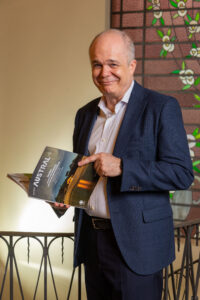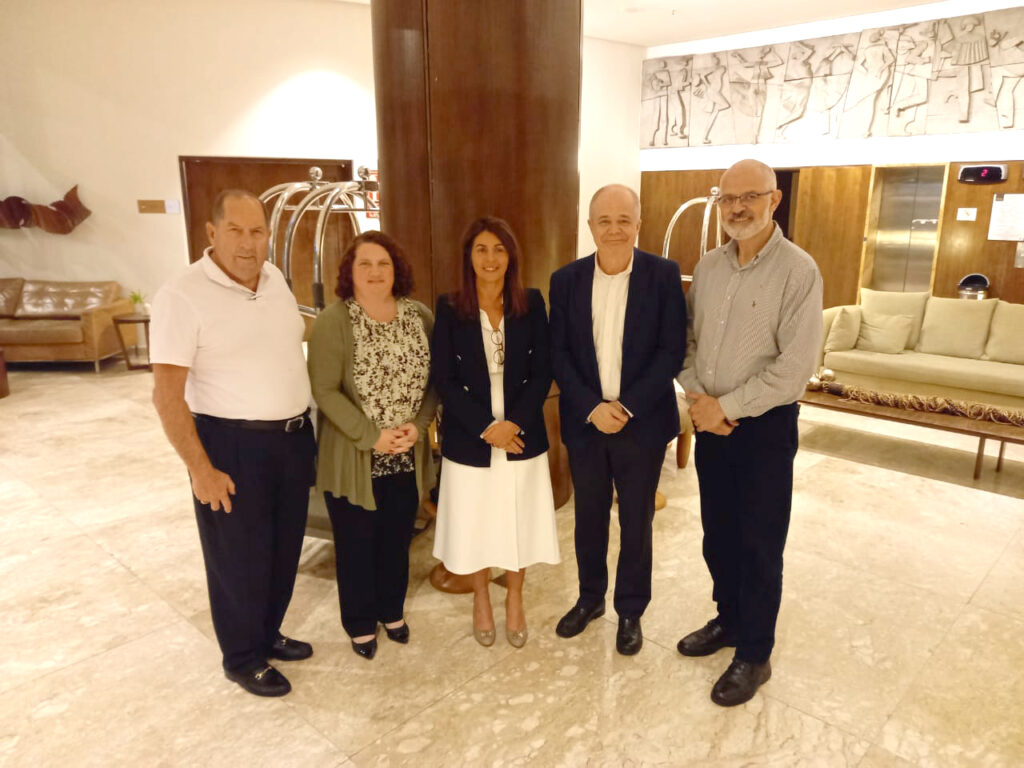Interview with Eduardo Fairen Soria, CEO, and Lisa Mota-Pinto McNally, CCO, TAAG Angola Airlines. By James Foster, Chairman, AirlinePros
Brazil is an important market for TAAG – the airline flies from Sao Paulo to Luanda three times a week currently and has excellent onward connections to several destinations throughout Africa in addition to Lisbon and Madrid in Europe. Overall, the potential is great, supporting traffic demand with key transatlantic connections from Brazil to Africa and Europe via the Luanda gateway. In June this year TAAG appointed AirlinePros as their GSA in Brazil extending the successful, decade-old partnership in North America.

The only airline flying the South Atlantic route today connecting Latin America directly with Southern Africa, TAAG is in the cusp of a major transition – from being a state-owned carrier to a private one. In Brazil to attend a series of marketing and public relations events organized jointly with AirlinePros, James Foster, Chairman, AirlinePros, caught up with Eduardo and Lisa to share some updates from the new developments at the airline including the launch of flights between Luanda and Madrid which complements the airline’s existing European flights to Lisbon as well as the signing of long-term leases for six new Airbus A220-300 aircrafts.
From Head of Operations and Training at Air Arabia Maroc to Chief Operations Officer at Camair and Chief Executive of Viva Air Peru, and now, CEO of TAAG. Is there a deliberate attempt at upping the challenge quotient in your career path?
Eduardo: I like challenges, if it’s not challenging, then it’s not fine for me. All throughout my career, I have taken up the most challenging offers that came my way. I need the excitement, you can say, I thrive on turning things around.
Lisa: Yes, I can second that. With Eduardo, he knows where he is going and he is fearless. And I can say it’s the same for everyone on the TAAG team now. We are all here because of our love for challenges. You can say, it’s a collective feeling.
TAAG, the flagship carrier of Angola, is expected to be a private entity in the next few years. What are the main challenges you expect from the transition?
Eduardo: While the transformation itself is an ongoing process, there are two parts to it. The implementation of the privatization process is one part, the full-time transformation is something that it different altogether. I believe that by 2025 we should be in a position to privatize the airline completely. But a lot of things need to be done before that, a lot of changes need to be brought about – we need to change the plan, the business model, the culture, among many others. And above all, we need to create the right value to bring in the right kind of investors.
Lisa: Yes, the change Eduardo is talking about is of paramount importance. We need to change the people’s mindsets first. We need to bring in the right people for the right position as well as change the speed with which we make our decisions. Yes, speed is of essence here as well. We need to be more commercial; normally government-owned companies do not have a great pressure on bottom line results. But we need to change that, we have to bring in more accountability. If you want to be an international company, you need to think and act like one!

The business strategy for TAAG, you said rather simply but realistically, was ‘back to normal.’ How is ‘back to normal’ faring so far?
Eduardo: Yes, I did say it, but of course, it’s not as simple as it sounds. We are not back to normal yet, but we are on the way. And there is some more way to go before we become normal. Like for instance, we need to recover our full fleet operation for one. During Covid, we were grounded, like most other airlines, for nearly six months. And as you know to ‘return to normal’ is no easy task and I had given ourselves at least one year in sheer operational terms since I joined in October last year. We are looking at a back to full fleet scenario by October 2022. Today we have 21 aircraft and we are managing 24, including leases, and our plan is to have 52 by 2026. Here you are looking at more than a 100 per cent growth.
Lisa: In addition to our enhanced passenger capacities, you will also be seeing a lot of emphasis on cargo which is about creating a separate operation in principle. Then its not again as easy as it sounds: industry standard says if you grow above 20 or 25 per cent you could run into trouble posed by crew and maintenance challenges. Then you know we like challenges, right? Our ‘return to normal’ has also been aided by a very proactive management which takes our recommendations immediately and at the same time are also quick to take decisions. We don’t waste any time, a quick turnaround is what we strive for in everything.
Six new Airbuses are coming your way from next year onward; the new terminal in the upcoming Luanda International Airport is slated to be up and running from around the same period. What other good tidings for the airline are in store in the near future?
Eduardo: There are a lot of good things coming our way, all thanks to our proactive team and management. We hope our new terminal at the airport will be finished up by early next year. We already have a team of 20 people working on the ground at the terminal to ensure that all our requirements are taken care of, everything related to infrastructure, design, services and branding. Work is in full swing – and we need to install systems, flight operations and get a lot of other things also up and running. But we are getting there.
Lisa: Everyone is putting their best foot forward to make sure the terminal will be something we can all be justly proud of. Though we do not have the full details yet, we know for a certainty that it is going to be a very beautiful, modern terminal, quite well-laid out – and that our presence will be fabulous with our brand featured prominently. We cannot divulge all the details now – as it’s a work in progress – we suggest you will have to come and see it – perhaps it can be the subject of a follow up interview with us?
TAAG’s recent acquisition of Dash 8s have freed up the 737s, probably for the longer hauls and to reinforce the busier shorter routes. Besides a 30 per cent saving on fuel, your new A220s could also make the previously unprofitable routes profitable with also their increased capacities and range flexibilities. Is this the gameplan?
Eduardo: Our aim is to have two sets of aircrafts by 2026 – one dedicated to full passenger services and the other to cargo as we are growing in the cargo area. This will be applicable to both wide and narrow body aircrafts. The A220s will become our backbone, as you rightly pointed out, while the 737s will remain in service probably till 2025. By then we intend to take a decision on whether to remarket them or to convert them into freighter services.

Your partnership with Iberia has been momentous for both the parties. Besides linking 143 international destinations through the Iberian network for you, you have also opened your part of the world for them. Are there are many more similar partnerships on the way?
Eduardo: You are right, the Iberian partnership has been quite a milestone for us, worked well for both the involved parties. We have several potential partnerships on our radar – we are looking at Namibia, South Africa, Mozambique and Central Africa, among others. Route development is a core function when it comes to expansion plans for an airline; we need to operate strategic routes and we are going to acquire enough fleet not only for our current services but also for special joint operations with our partners.
Lisa: We need to identify and evaluate the feasibility of new routes which is intrinsic to route planning. If we offer just weekly, regular services, we might not make the mark we envisage. You cannot have only strategic routes until you have become profitable. The idea is to work with partners like Iberia to connect to places to which we usually don’t operate and to thereby widen the TAAG offer substantially.
Thank you for being a valued partner of AirlinePros, we hope to recreate the magic we made together in North America.
Lisa: Well, thank you Jim, and to the AirlinePros Team in Brazil including Altamiro and Rebecca. Ever since you came onboard as our GSA, the market response has been most gratifying. We have since then grown from three frequencies between Sao Paulo to Luanda to four beginning November 5 and we have just announced a fifth weekly effective December 9. So, please keep up the good work!
We surely will!
Airline updates: Recently TAAG got the IOSA accreditation, the international air safety audit. This approval reinstates the airline’s own alignment with the best practices of the international aviation industry and its continuous improvement of operational safety services and management policies. The certification shows TAAG’s commitment to reinforce credibility, operational capacity and contribution of value to passengers and stakeholders.
